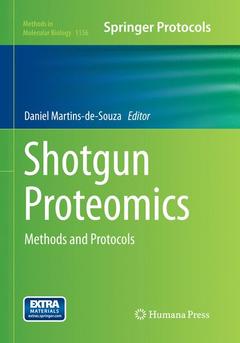Description
Shotgun Proteomics, Softcover reprint of the original 1st ed. 2014
Methods and Protocols
Methods in Molecular Biology Series, Vol. 1156
Language: English
Subjects for Shotgun Proteomics:
Publication date: 04-2017
Support: Print on demand
Publication date: 05-2014
492 p. · 17.8x25.4 cm · Hardback
Description
/li>Contents
/li>Comment
/li>
Shotgun Proteomics: Methods and Protocols serves as a vital collection of protocols through which thousands of proteins can be simultaneously identified, quantified and characterized in a high throughput manner. Beginning with the history of proteomics centered on the vital role of mass spectrometry in its development, this detailed volume continues with chapters on sample pre-fractionation, in vivo and in vitro stable isotope labeling, label-free proteomics, informatics, protein-protein interactions, targeted proteomics and post-translational modifications. Written for the highly successful Methods in Molecular Biology series, chapters include introductions to their respective topics, lists of the necessary materials and reagents, step-by-step, readily reproducible laboratory protocols and tips on troubleshooting and avoiding known pitfalls.
Practical and comprehensive, Shotgun Proteomics: Methods and Protocols is an ideal and up-to-date guide for researchers seeking to understand the proteome of any given species.
Survey of Shotgun Proteomics.- LC-MALDI-TOF/TOF for Shotgun Proteomics.- Fully Automatable Multidimensional Reversed-Phase Liquid Chromatography with Online Tandem Mass Spectrometry.- GeLC-MS/MS Analysis of Complex Protein Mixtures.- IPG Strip-Based Peptide Fractionation for Shotgun Proteomics.- SILAC Yeast: From Labeling to Comprehensive Proteome Quantification.- Analysis of Proteome Dynamics in Mice by Isotopic Labeling.- Stable Isotope Labeling in Mammals (SILAM).- Analysis of Individual Protein Turnover in Live Animals on a Proteome-Wide Scale.- Determining Protein Subcellular Localization in Mammalian Cell Culture with Biochemical Fractionation and iTRAQ 8-Plex Quantification.- Brain Quantitative Proteomics Combining GeLC-MS and Isotope-Coded Protein Labeling (ICPL).- Employing TMT Quantification in a Shotgun-MS Platform.- Employing TMT Quantification in Shotgun-MS Proteomic Analysis: A Focus on Skeletal Muscle.- Spectral Counting Label-Free Proteomics.- Quantification of Proteins by Label Free LC-MSE.-Bioinformatics for Proteomics: Opportunities at the Interface Between the Scientists, Their Experiments and the Community.- Identification of DNA Damage Checkpoint-Dependent Protein Interactions in Saccharomyces cerevisiae Using Quantitative Mass Spectrometry.- Application of Shotgun Proteomics for Discovery-Driven Protein-Protein Interaction.- Mapping Protein Complexes Using Covalently Linked Antibodies and Isobaric Mass Tags.- Biomarker Verification Using Selected Reaction Monitoring and Shotgun Proteomics.- Use of Universal Stable Isotope Labeling by Amino Acids in Cell Culture (SILAC)-Based Selected Reaction Monitoring (SRM) Approach for Verification of Breast Cancer-Related Protein Markers.- The Secretome Analysis by High Throughput Proteomics and Multiple Reaction Monitoring (MRM).- Preparation of Heteroelement-Incorporated and Stable Isotope-Labeled Protein Standards for Quantitative Proteomics.- One-Source Peptide/Phosphopeptide Ratio Standards for Accurate and Site-Specific Determination of the Degree of Phosphorylation.- Quantitative Glycoproteomics for N-Glycoproteome Profiling.- A Practical Recipe to Survey Phosphoproteomes.- Quantitation of the Phosphoproteome Using the Library Assisted eXtracted Ion Chromatogram (LAXIC) Strategy.- Fast, Efficient and Quality-Controlled Phosphopeptide Enrichment from Minute Sample Amounts Using Titanium Dioxide.- Quantifying Small Molecule-Induced Changes in Cellular Protein Expression and Post-Translational Modifications Using Isobaric Mass Tags.- Analysis of Protein Structure by Crosslinking Combined with Mass Spectrometry.- Top Down Proteomics by Means of Orbitrap Mass Spectrometry.




